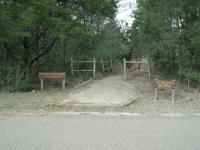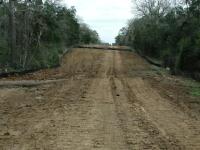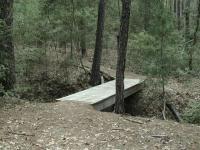
The trailhead resides at the back of the loop road that encircles the park lake.
From Austin head east on Highway 71 and drive past
Bastrop toward Smithville. Turn left north of Smithville and head north on
FM 153 for half a mile and turn left into the park. After paying for park entrance
drive past the ranger station and turn right onto Park Road 1E. Drive around the
small lake and look for the brown signs that mark the trailhead on the right.
Parking is on the opposite side of the road.
The Hikes: Buescher State Park is a sibling of the nearby Bastrop State Park.
Despite its close proximity and the fact that it also features a portion of the Lost Pines the
park tends to host fewer visitors. If you crave hiking solitude you can use this to
your advantage.
The trail starts off at the waypoint "Trailhead" and heads in a northwest direction for about 1/3rd of
a mile before coming to pipeline right of way. This pipeline right of way is none other than the
Longhorn Pipeline that has been in the news as of late. During my hike the pipeline crews just so
happened to be working in the area, though not immediately along the trail.
-small.jpg)
Buescher includes a portion of the mysterious Lost Pines.
Not wanting to give up the hike I continued to walk along the pipeline route and
occasionally had to step over erosion control barriers. Off in the distance I could see
some work being done on the pipeline even though it was Sunday. Thankfully after half a
mile the trail proper continued again at the waypoint "Y-Right". After a short distance
back into the forest I was able to leave the commotion behind me.
The trail soon turns more to the north. Although it begins to come into contact with
Park Road 1C this does not hamper solitude too much. Traffic along the road is light.
On nice days bicyclists may outnumber drivers. The road connects Buescher State Park
with its sister Bastrop State Park. The route is quite popular with cyclists.

A half mile of the trail is along a pipeline right-of-way. During my hike this pipeline was under repairs, making for a less than natural experience.
Buescher State Park's shape somewhat resembles a gerrymandered Congressional district. One
of the reasons for this can be found at the "Road Cross 1" waypoint. Here the trail
crosses the entrance to the University of Texas cancer research facility. At some point
in the past part of the park was set aside as a research campus. The remaining land snakes
around this research park.
To complete the full trail loop always choose the right fork in any split in the trail.
Although Buescher shares many characteristics with its sibling park it does not include
as many ponds, the Houston Toad's preferred mating grounds. However there is one pond
along the trail visible at the waypoint "Pond".

All creek crossings are easily done. Some include a small footbridge to make the crossing even easier.
Prior to my hike a strong storm had moved through the area and blown some trees down and
weakened others. The quiet of the hike was shattered for a moment as one of the pines
finally collapsed to the ground not too far off trail. Though the experience caused me
to wonder about the structural integrity of some of the trees along the trail that I
passed I realized that any danger was very remote and that my witnessing the event was
in a sense a bit of luck.
Contrary to what the official trail map states the road crossing at "Road Cross 2" does not
traverse a dirt road. That is now paved. However, the road appears to be still be quite
lightly used and crossing is not a problem.
-small.jpg)
The Lost Pines are one of the most interesting hiking areas in Central Texas.
Once across the road the most interesting portion of the hike begins. The terrain on
the northwestern side of the park is more rugged and heavily forested. In some places the
falling pine needles are so numerous that they hang in clumps like moss on smaller trees
and bushes. The steeper terrain is cut by a number of small creeks in this portion of the park. The
trail crosses many of the streams, most of which will be dry except during rains.
The rougher terrain, denser foliage and fewer park visitors probably account for the
group of deer that I saw on the back end of the trail. I crouched down and remained
silent trying to observe them for as long as possible. Playful screams from bicyclists
on Park Road 1C caused them to make a hasty retreat farther away from the road.
-small.jpg)
Strong winds had knocked many trees down, including some across the trail. During my hike I heard another crash down not too far away.
The trail crosses Park Road 1C at the "Road Cross 3" waypoint and soon thereafter turns to
the south. I turned right at the waypoint "T-Right" in order to extend the outer loop.
Going left will rejoin the trail along the park road sooner. Much of the elevation gain
is found in this portion of the hike. The hiker is propelled up and down ridges until the
trail meets up again with Park Road 1C and very soon thereafter with the return route back
to the trailhead.
During my hike on a pleasant Sunday I did not see one single other hiker on the trail.
The only sign that anyone else was even out there was a wildflower book that I picked up
on the way back to the trailhead, which I left at the lost and found desk of the ranger
station. The book was not there on the way out, so someone MUST have been out there with
me. Still, though I did not see other hikers I did see pipeline construction workers off
in the distance and a few drivers and bicyclists along Park Road 1C. This hike
provides ample opportunity for getting away from the crowds found on many area trails.